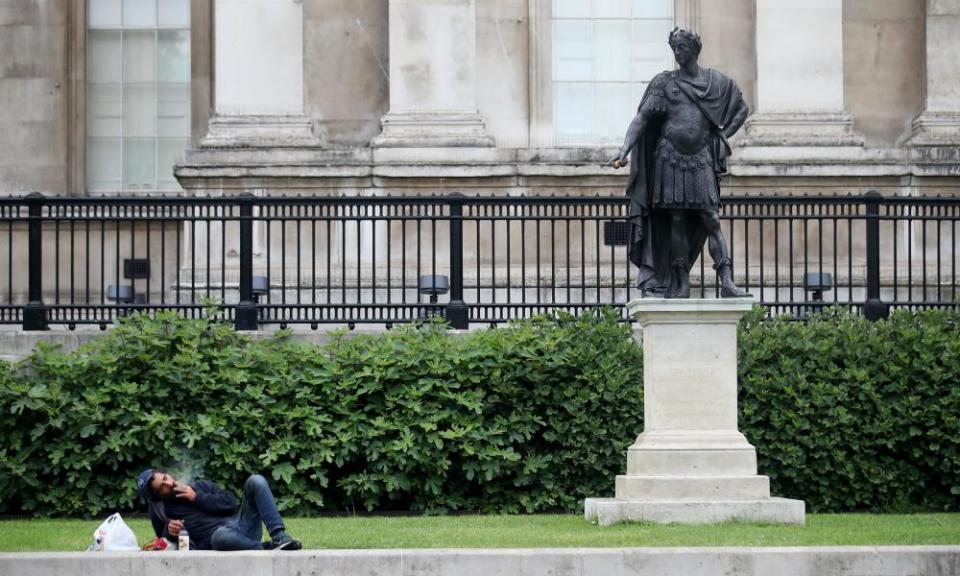National Gallery urged to lead the way with statue to honour slaves

The National Gallery is being called on to become the first UK public institution to build a “counter-monument” to the slave trade.
Last Thursday the London gallery announced the six shortlisted design teams that will compete for a £30m project to mark its bicentenary in 2024. The NG200 plans include revamping the main entrance in Trafalgar Square, with an opportunity to “reimagine the public realm” by linking its 1991 Sainsbury’s Wing with the historic setting of the Wilkins Building.
Prof Fred Steward of the School of Architecture and Cities at Westminster University, said this could be a chance to create “an imaginative counter-monument of national contrition for our central role in the slave trade”. As part of its plans, he argued, the gallery could address the issue of the 1.5 metre bronze statue of James II in its front garden. In 1660, before he became king, James Stuart was a founder of the Royal African Company, which sent more than 200,000 African slaves to the Americas.
The proposal fits new official government policy to “retain and explain” contested statues. Steward’s call has also been endorsed by the mayor of London, who set up a commission for diversity in the public realm in February. A spokesperson for London Labour said: “Sadiq firmly supports a number of new memorials in the capital … he also wants to see new educational programmes to ensure all Londoners learn about the horrors of the slave trade and the role it played in our history.”

In a crowdsourced Topple The Racists map published by the Stop Trump coalition last year, James II largely escaped noticedespite being a crucial central figure in England’s early conquest of the global slave trade. “He was in charge of the company for 16 years … and under his leadership, it dominated 74% of the slave trade worldwide,” said Steward. “Why aren’t we taught this in schools? This is an opportunity to show that the country is ready to acknowledge the darker side of its colonial past.”
One of the NG200’s shortlisted architecture practices contacted by the Observer agreed that they would be keen to address the challenge to build a counter-monument to meaningfully explain the black lives devastated by slavery.
English Heritage, which looks after 48 statues and monuments in London, emphasised that while the James II statue was not erected by the organisation, it was the charity’s responsibility to ensure it was “properly maintained”. A spokesperson agreed that “more needs to be done to better explain [its] context” and supported a commitment to “telling the story of England to its fullest”.
Duncan Wilson, chief executive of Historic England, said the public body recognised “the importance of enhancing our collective understanding of this part of our history” as “England’s heritage is for everyone and our role is to ensure that all the many different aspects which helped to shape it are fully understood.” As the government’s heritage adviser, Wilson acknowledged it was “important to open up the conversation” but would only advise on official proposals “as and when needed”.
But despite vaguely supportive noises from official bodies for similar projects, promises to memorialise the fuller story of Britain’s past have largely been empty. Black volunteers for Memorial2007, for instance, have been campaigning since 2002 for a permanent site of remembrance to slavery to be built in Hyde Park. The project has been designed with planning permission and has been endorsed by Unesco and the DCMS, and was promised funding by Boris Johnson in his role as mayor of London. The project requires £4m to be realised; its crowdfunder has raised just under £10,000.
Protests against racial injustice saw the toppling of just one statue – of Edward Colston in Bristol, which had long been the focus of local contention, but debate about Britain’s monuments has raged on.
Dr Gabriele Finaldi, director of the National Gallery, said: “We have not provided a detailed brief so, while we are looking for the successful team to reimagine the public realm outside the Sainsbury Wing and along the northern edge of Trafalgar Square, it is too early in the process to comment on what this might involve.”
Kojo Kyerewaa of Black Lives Matter UK told the Observer that removing statues of slavers was not a priority. “While we support calls for monuments to recognise the horrors of the transatlantic slave trade, BLM UK will not be focusing our energy on it,” he said. “Monuments have meaning, but our ambitions go beyond remembrance. Our movement exists to undo plunder and violence of African countries and peoples by the UK. We want an end to this government’s exploitation of colonised peoples. We want to dismantle structural racism by ending exploitative trade relations, defunding the police and transforming education.”

 Yahoo Finance
Yahoo Finance 